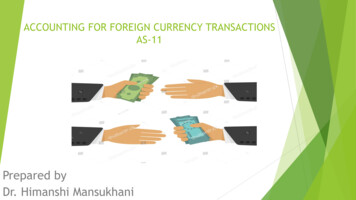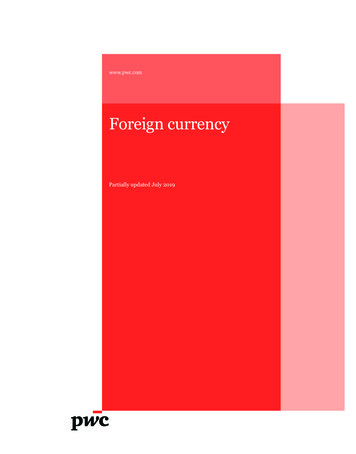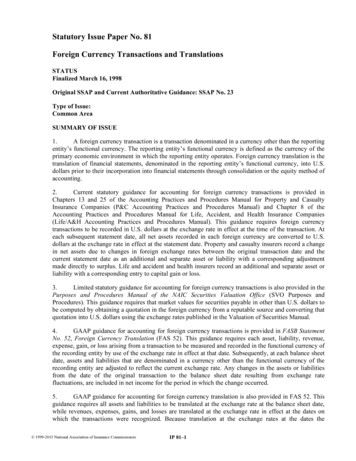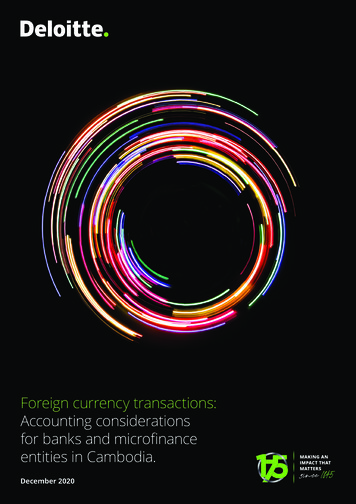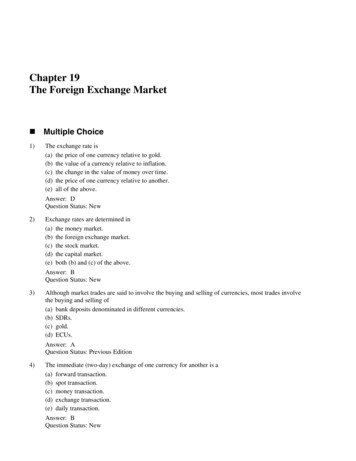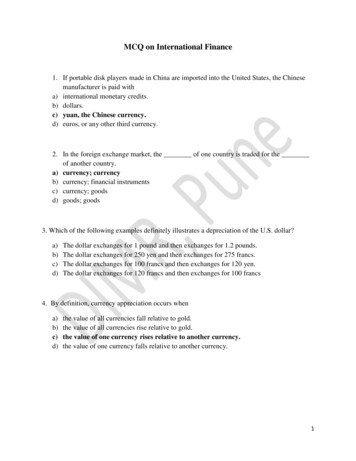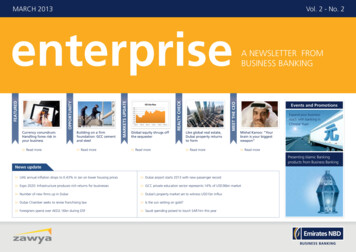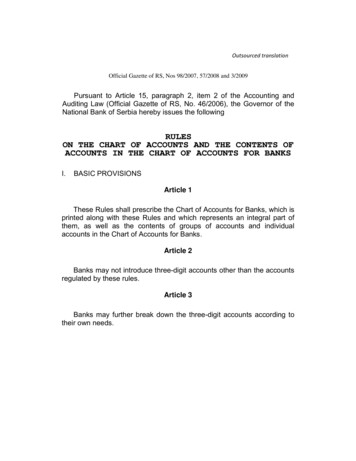
Transcription
CS229: Foreign Currency Exchange Rate ForecastJiahao ZhangJialu SunJiequan nz@stanford.eduJune 13, 2019Abstractforecasts face its own great challenges. Meese and Rogoff[6] have pointed out that even the simplest random walkmodel can defeat complex structural econometric models in foreign exchange forecasting. In the past decades,researchers have tried various combinations of economicvariables and econometric methods to challenge Meeseand Rogoffs finding. There have been some impressiveadvances, but most results are fragile due to the nonlinearity and noise of the foreign exchange data, which makesforeign exchange forecasting an impossible mission. Withthe development of the computation and machine learningtechniques, we are curious about whether we can addressthe impossible mission with the help of modern machinelearning methods, and whether some certain methods cangenerate systematically superior forecasting performance.In view of todays global economy, countries around theworld are getting more connected and linked to each othervia trade, technically known as import and export activities. To allow a monetary transaction to take place duringa trading process in a systematic and coherent manner, exchange rate plays a prominent role. However, due to theuncertainty and volatility in the worlds economy, the participants of such trading activities are vulnerable and exposed to risk. Therefore, the ability to accurately forecastthe exchange rate offers a solution to mitigate this risk. Inthis project, we attempt to forecast the exchange rate forUS Dollar expressed in terms of the British pound (GBP),the Euro (EUR), and the Japanese Yen (JPY) through signprediction and trading strategy backtesting. The exchangerate forecasting is conducted by a number of machinelearning techniques. The backtesting results of our trading strategy suggest that in this research, Random Forestapproach is a more suitable forecasting method to predictthe exchange rate for a short period of time.1In essence, machine learning methods are used toproduce the best out-of-sample forecast of a quantity/category of interest based on given conditioning information, which justifies the suitability of machine learningmethodologies for financial asset return forecasting [3].Recently, most studies apply machine learning techniquesin stock return and bond risk premia prediction, but fewliteratures analyze the application of machine learning inforeign exchange forecasting. In this project, we will fillin this gap by extensively testing both classical and advanced machine learning techniques.IntroductionThe foreign exchange market is the largest and most liquid financial market in the world. In 2016, the trading inforeign exchange markets averaged 5.09 trillion per day.Foreign exchange trading can influence the purchase offoreign goods and services and investment abroad on theindividual, corporate, and even government level. Therefore, exchange rate forecasting is very important to examine the returns and risks attached to the internationalbusiness environment.Unlike other financial assets, current exchange rateIn the first stage of this project, we try to do sign prediction, which is a binary classification of whether or not thestock price is going to increase. In the second stage, weswitch to predict log return values directly. Based on thepredicted value of the returns, we formulate some practicable trading strategies and backtest them based on realdata to see if some forecasting method can significantlybring economic values.1
2Related WorkMachine learning techniques have been applied for financial asset forecasting and empirical asset pricing decadesago. With the fast development in computation and learning techniques, machine learning methods began to gainmore attention in finance research in recent few years.Most of the recent research use machine learning techniques in stock return prediction, bond premia prediction,and housing prices prediction. Specifically, [3] conducta comparison of machine learning methods for predictingthe panel of individual US stock returns. [7] and follows asimilar approach as [3] to predict stock returns with neuralnetworks.However, compared to other financial assets, little literature has been applying machine learning methods forforeign exchange forecasting. [4] investigate the out-ofsample forecasting ability of feed forward and recurrentneural networks based on empirical foreign exchange rateand find that some networks have significant market timing ability and lower out-of-sample prediction error relative to the random walk model. [9] find that, RandomForest performs bettert hat Support Vector machine whentraining with empirical commodity price data. By the inspiration of current literature in foreign exhcnage foreacsting using ML techniques, we would do a tentative experiment on the forecasting power of ML techniques inforeign exchange assets.33.1Figure 1: The Exchange Rate of GBP, JPY and EUReconomic and financial features including the S&P 500index, the S&P 100 index, the Nasdaq index, the DowJones Industrial Average, the rate of change in consumerprice index, the federal funds, the NBER based recessionindicator and the federal debt. The economic and financial data above are obtained from Center for Research inSecurity Prices.We split the data and features to training, validation andtest set by the ratio of 0.8:0.1:0.1.3.2FeaturesFeature Selection is one of the core concepts whichhugely impacts the performance of our models.In our initial design of the sign prediction experiment,we fed seven features into the model, including the log return of the current day, the log return of the last day, andsimple moving averages of the log return of today (thepast 5, 10, 20, 60, and 120 days). During the training process, we found the seven features only were not sufficientto provide enough predicting power for our three currencypairs, so we extensively constructed and tested more engineered features out of our exchange rate data to assistour forecasting and avoid under-fitting. As a result, wefigured out some empirically helpful features, such as thelogarithm of the closing prices and its moving averages toour model, and we ended up accumulating 15 features toour feature library, which additionally includes the log ofthe actual exchange rate value, its square, its cube, and itssimple moving averages (the past 5, 10, 20, 60, and 220days).For the trading strategy backtesting part, we directlyDataset and FeaturesDatasetWe use the daily closed price of the foreign exchangerate of three major currency pairs, US Dollar to Britishpound (GBP/USD), US Dollar to Euro (USD/EUR), andUS Dollar to Japanese Yen (USD/JPY) from January 2001to December 2018. Our data source is from BloombergTerminal. Figure 1 shows the main trend of the foreignexchange rate of the three currency pairs.For the classical time-series models, the models areonly fed with the exchange rate changing history. Thisis based on our assumption that it might be possible topredict the exchange rate by looking at the previous pattern only. For other models, we incorporate more macro2
4.3forecast the values of the log returns of each currency pair.In an attempt to extract more information from the economic environment and financial markets, we also considered some economic and financial factors into our forecasting problem and ended up incorporating several USmarket based economic and financial factors to our feature library. Detailed description of our economic and financial features is in Section 3.1.4Multilayer perceptions is a type of neural networks, whichis most commonly used in the literature of artificial intelligence. In 2011, [2] introduced a time-delayed multilayerperceptron neural network with gold price as external factor to predict the exchange rate of EUR/USD, GBP/USD,and USD/JPY. In general, a multilayer perceptron withtwo hidden layers can be illustrated asX (2) X (1)ok f (wkj g(wij x))(1)Methodsj4.4We extensively tested different kinds of machine learningtechniques in the application of foreign exchange forecasting. The machine learning techniques we applied includes Random Forest, Support Vector Machine , Multilayer Perceptron, Lasso, and Ridge. We use the validationset to select our models and we use the test set for ourbacktest (described below).Random ForestLasso & Ridge2(yi yˆi ) i 1MX(yi i 1pX2wj xij ) λj 0pXwj2 (2)j 0Lasso Regression: The cost function for Lasso (leastabsolute shrinkage and selection operator) regression canbe written asRandom Forest is a method that evolves from decisiontrees [5]. It is capable of both classification and regression. It uses multiple decision trees and bagging to doprediction. The basic idea the following. First, for eachdecision tree, we acquire a group of sample from the original data with replacement (bagging). Second, we get theresult from all decision trees and take the majority (classification) or average (regression). In the random forestmodel we use, the number of trees in the forest is 1000and the maximum depth of each tree is 100.4.2iRidge and Lasso regression are some of the simple techniques to reduce model complexity and prevent overfitting which may result from simple linear regression.Ridge Regression: In ridge regression, the cost function is altered by adding a penalty equivalent to square ofthe magnitude of the coefficients.MX4.1Multi-layer PerceptronMXi 155.1(yi yˆi )2 MX(yi i 1pXj 0wj xij )2 λpX wj (3)j 0ExperimentsSign Prediction (classification)In the finance world, sign prediction can yield importantinformation for financial decisions such as market timing. We will compare out-of-sample forecasting abilitybetween these models as well as these models’ losses onsome metrics. These metrics include Normalized MeanSquare Error (NMSE), Mean Absolute Error (MAE), Directional Symmetry (DS), Correct Up trend (CU) andCorrect Down trend (CD).For sign prediction, We plan to use several machinelearning techniques including logistic regression, LassoSupport Vector MachineThe basic idea of the SVM is to find a maximum marginthat separates a training set into the positive and negativeclasses, based on a discriminant function that maximizesthe geometric margin. In the paper of [1], they focus onemploying SVM for USD/EUR exchange prediction using the Mackey-Glass dataset and yield an range of appropriate parameters for the SVM.3
6and Ridge, SVM with kernel[8], Random Forest, NeuralNetworks such as CNN.Results and Discussion6.15.2Table 1 shows the result of our preliminary experimentswith different machine learning models.Profit Simulation Experiment (regression)ModelLassoRidgeLogisticSVMrbfRandom ForestMLPWe also designed an experiment to see if the random forest model can help us make money. We are using the actual predicted exchange rate return values instead of signin this experiment. We assume that we have 100 dollars. All the exchange rates here are USD/other currencies. Our test set for EUR starts are March 3 rd, 2017 andour tests set for GBP and JPY start at March 7 rd, 2017.They all end at November 30th, 2018. When we are doing this experiment, we assume our start date to be March3 rd, 2017 and for the first couple days we only considerEUR. The way we do this experiment is the following.ExchangeRatet D0.580.510.570.520.490.52Table 1: Comparison in predicting the sign of exchangerate among different machine learning techniquesAll these values were the average values of the 3 currencies (British pound (GBP), the Euro(EUR), and theJapanese Yen (JPY)) with respect to US dollar. As wecan see, the accuracy values based on the models are allaround 50%. In fact, although the prediction accuracy isnot very satisfactory, the result is in accordance with ourexpectations; currency exchange rate prediction is currently one of the most challenging topics in the field ofeconomy and and it is considered almost impossible tomany experts. Therefore, aside from attempting to accurately predict the actual sign of return values, we are moreinterested in testing if our model can help us maximizeprofit in currency trade within a period of time,First, for one day, we collect all the predicted returnvalues on our exchange rate.The predicted return at time tis:returnt Sign Prediction(4)Second, if all return values are larger than 1, than wedo nothing; if there are some return values lower than1, then we ”switch” to the currency that has lowest exchange rate return with USD for one day and ”switch”back. For example, if USD/GBP is 1.0, USD/EUR is 1.02,and USD/JPY is 0.95, then we will use our 100 to ”buy”some JPY, and then ”buy” USD back at the end of theday, so at the end of the day we will have 105.26 USD(100/0.95). This is because if the return is lower than one,the value of USD is decreasing with respect to the othercurrency.6.26.2.1Trading Strategy Backtesting ExperimentModel SelectionWe use the coefficient of determination, R2 ,of the prediction to measure our model and we averaged the scores forall three exchange rates. According to Scikit-learn, thebest possible score is 1.0 and it can be negative and a constant model that always predicts the expected value of y,disregarding the input features, would get a R2 score of 0.The definition of R2 is:During this experiment, we only take into account exchange rates that are available. Different places have different holidays, so at some days not all three exchangerates is available. For example, if for one day, EUR is notavailable, then we only use the data for JPY and GBP; iffor one day, all three exchange rates are not available, weskip this day.R2 1 4uv(5)
u SU M ((ytrue ypred )2 )(6)v SU M ((ytrue mean(ytrue ))2 )(7)Table 2 shows the scores for each model. According tothis table, we select Random forest as our model.R2R2RF0.74SVM poly-0.02MLP-infLasso0.01SVM rbf0Ridge0.01Figure 2: Prediction results.Table 2: Coefficient of determination for each modelIt is interesting to see that although the Random Forest model performs poorly in the sign prediction experiment, it turns out to be a good model to adopt in the profitsimulation experiment. One possible explanation for thisis that the RF method, as we can see in Table 1, has arelatively high score in the matrices NMSE and MAE,which measure the difference between the true exchangerate and the value our models predict, Although the RFmethod cannot make an accurate prediction of the signsof future exchange rate, it will give a predicted value relatively close to the true value each time. Therefore, theRF method is more flexible than other models and lesslikely to make major mistakes when conducting the profitsimulation experiment. We believe the RF model can beused as a good reference while doing profit prediction ina short period of time.6.2.26.2.3Trading strategy Backtesting ResultTable 3 below shows the final amount of money we havefor each different currency combinations. Here if the column is ”JPY”, then we only consider JPY for all dates; ifthe column is ”GBP JPY”, then we are considering GBPand JPY but not EUR for all dates.FinalFinalFinalGBP104.40GBP JPY100.33GBP JPY EUR101.30JPY104.44JPY EUR109.46EUR110.5GBP EUR104.88Table 3: Final cash in the experiment for all casesFigure 3 shows the variation of our cash. The first oneis when taking all three exchange rates into account (JPY,GBP, and EUR). As we can see in this plot, our portfolio value peaks around 112 at about March 2018, buteventually drops to 101.30 . The starting time is March3rd, 2017 and the end time is November 30th, 2018. Thismeans that our model works well in trading signal prediction during March 2017 and March 2018, but fails toadjust to the regime change after March 2018 when wetake all three exchange rates into account. The second,third, and fourth plot are for only portfolios only considering GBP/USD, USD/JPY, and EUR/USD respectively.Prediction resultFigure 2 shows the results of our RF model for all threeexchange rates. The X axis is days (March 3rd, 2017 toNovember 30th, 2018) and the Y axis is the log of thereturn of exchange rates. The blue points are the predictedlog returns and the green points are the actual log returns.Just by looking at these plots, the results (log return) arenot that precise. It is also hard to judge if our modelsare useful by only looking at this figure. In the world offinance, what we care about is if we can make money. Theresult of the experiment(next section) is more meaningful.5
7As we can see, different currencies have different experiment results. We can notice that the portfolios tradingexclusively in GBP/USD and EUR/USD also experiencesuch plunge of portfolio values after March 2018. We investigated thoroughly about the reasons for the failure ofour trading strategy. We found that, Trump’s governmentstarted to impose tariffs on steel and aluminum importsfrom all suppliers since March 2018, which signifies theoverture of the trade war between China and the U.S. Weknow that the balance of trade between 2 countries influences foreign exchange rate through the its effect onthe supply and demand for foreign exchange. Therefore,the declaration of the ”trade war” might have changed theregime of the foreign exchange rate dynamics of the threecurrency pairs we considered. Since our parameters forthe trading strategy were predetermined before the testingset, we are not able to adjust the generating of our trading signals, which might have led to a huge loss after thechange of the market environment.Conclusion/Future WorkIn conclusion, with our models selected above, it is veryhard to get high accuracy trying to predict the sign of logexchange rate return (or if the return is larger of smallerthan 1). However, the random forest model can help usmake money sometimes. In different periods and for different currencies, the model has different performance.The next step will be to further investigate into this issue. We expect to consider more economic and financialmarket factors to capture the regime changes in foreignexchange markets. Another applicable change in our predicting method is to shorten the forecasting window of ourmodels and retrain the prediction model with a shorter period.We can also try to adopt recurrent neural networkswhich work better with information hidden in time series,including LSTM, gated recurrent units, simple recurrentunits, etc. Also, expanding our factor library with morediversed economic factors should also generate better prediction power.8ContributionsTeam members:Jiequan Zhang:Writing code to run models, plotting,designing and implementing the experiment.Jiahao Zhang: Data collecting, data preprocessing,models, report setup, poster setup, experiment designJialu Sun: Literature Review, Data collecting, Traditional Econometric modelsFigure 3: Cash Variation9Table 4 shows the coefficient of determination, R2 , ofthe prediction for our random forest model. These scoresare calculated using the test set.R2GBP0.70JPY0.74Github Linkhttps://github.com/Jiequannnnnnnnnn/CS229 Exchangge rateReferences[1] M. Alamili. Exchange rate prediction using support vectormachines. 2011. TUDelft.[2] M. Fathian and A. N. Kia. Exchange rate prediction withmultilayer perceptron neural network using gold price as external factor. 2011. GrowingScience.[3] S. Gu, B. T. Kelly, and D. Xiu. Empirical asset pricing viamachine learning. 2018. Chicago Booth Research Paper.EUR0.78Table 4: R2 for all three exchange rates (Random Forest)6
[4] C.-M. Kuan and T. Liu. Forecasting exchange rates usingfeedforward and recurrent neural networks. Journal of Applied Econometrics, 10(4):347, 1995.[5] W. Mao and F.-Y. Wang. Cultural modeling for behavioranalysis and prediction. 2012. New Advances in Intelligence and Security Informatics.[6] R. Meese and K. Rogoff. Empirical exchange rate modelsof the seventies. 1983. Journal of International Economics.[7] M. Messmer. Deep learning and the cross-section of expected returns. 2017.[8] H. Pesaran and A. Timmermann. A simple nonparametrictest of predictive performance. 1981. Journal of BusinessEconomic Statistics.[9] S. Ramakrishnan, S. Butt, M. A. Chohan, and H. Ahmad.Forecasting malaysian exchange rate using machine learning techniques based on commodities prices. pages 1–5,July 2017.7
The foreign exchange market is the largest and most liq-uid financial market in the world. In 2016, the trading in foreign exchange markets averaged 5.09 trillion per day. Foreign exchange trading can influence the purchase of foreign goods and services and investment abroad on the individual, corporate, and even government level. There-
